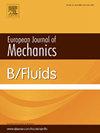垂直流中弱惯性粒子的沉降速度
IF 2.5
3区 工程技术
Q2 MECHANICS
引用次数: 0
摘要
我们研究了弱惯性颗粒在垂直水流中的沉降速度变化,这些颗粒与流体的密度比在 1.35 到 1.38 之间。为了评估湍流的影响,我们通过实验研究了颗粒和湍流之间的速度变化对物理尺度(包括时间、速度和长度)的依赖性。与停滞条件相比,湍流会增强或阻碍沉降速度。沉降速度的变化与颗粒的惯性和湍流强度有关。在湍流较弱或颗粒较大的情况下,沉降速度的变化很小,甚至会减小。相反,对于较小的颗粒和较强的湍流,沉降速度的变化更为明显,在 St≈O(10-3) 时达到最大增幅。我们将实验结果与现有的固液两相流研究结果进行了比较,发现了一致的趋势。在之前的研究和本研究中,长度尺度参数 StSv 在辨别决定湍流条件下沉降速度变化的惯性条件方面一直很重要。本文章由计算机程序翻译,如有差异,请以英文原文为准。

Settling velocity of weakly inertial particles in vertical flow
We investigate the settling velocity change of weakly inertial particles, whose density ratio to fluid ranges from 1.35 to 1.38, in vertical water flow. To assess the effect of turbulence, we experimentally examine the dependence of modifications of velocity on physical scales, including time, velocity, and length, between particles and turbulence. It is observed that the settling velocity is either enhanced or hindered by the turbulence compared to stagnant conditions. The change in settling velocity is observed to be responsive to both the inertia of particles and the turbulence intensity. In cases of weak turbulence or with larger particles, the settling velocity exhibits small changes and even decreases. Conversely, the change in settling velocity is more pronounced for smaller particles and in more intense turbulence, reaching a maximum increase at . We compare our experimental results with existing studies conducted in solid–liquid two-phase flow, finding a consistent tendency. In both prior research and the present study, the length scale parameter, , has consistently been important in discerning inertial conditions that determine the change in settling velocity under turbulent conditions.
求助全文
通过发布文献求助,成功后即可免费获取论文全文。
去求助
来源期刊
CiteScore
5.90
自引率
3.80%
发文量
127
审稿时长
58 days
期刊介绍:
The European Journal of Mechanics - B/Fluids publishes papers in all fields of fluid mechanics. Although investigations in well-established areas are within the scope of the journal, recent developments and innovative ideas are particularly welcome. Theoretical, computational and experimental papers are equally welcome. Mathematical methods, be they deterministic or stochastic, analytical or numerical, will be accepted provided they serve to clarify some identifiable problems in fluid mechanics, and provided the significance of results is explained. Similarly, experimental papers must add physical insight in to the understanding of fluid mechanics.

 求助内容:
求助内容: 应助结果提醒方式:
应助结果提醒方式:


